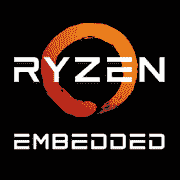AMD Ryzen Embedded V1807B

AMD Ryzen Embedded V1807B: Compact Power for Specialized Solutions
Relevant as of April 2025
Key Features: Zen Architecture and Performance Balance
The AMD Ryzen Embedded V1807B processor, released in 2018, remains in demand in 2025 due to its reliability and optimized architecture.
Architecture and Manufacturing Process
- Based on the first-generation Zen microarchitecture (14 nm).
- Despite its "age," the 14 nm process ensures stability and low heat output, which is critical for embedded systems.
- 4 cores / 8 threads with a base frequency of 3.35 GHz and turbo up to 3.8 GHz.
Performance
- Geekbench 6: 1055 (Single-Core), 3500 (Multi-Core). For comparison, the modern Ryzen 5 5500U (6 cores, 7 nm) scores around ~1300/4500, but consumes less power.
- L3 cache - 2 MB: a minimum for Zen, which limits tasks with high cache load (for example, rendering).
Key Features
- Integrated graphics Radeon RX Vega 11 (11 GPU cores, 1300 MHz).
- Support for ECC memory for enterprise solutions.
- TDP of 45 W: a balance between performance and energy efficiency.
Compatible Motherboards: Choice for Embedded Systems
The Ryzen Embedded V1807B uses the FP5 socket (BGA), which means it is integrated into industrial application boards.
Chipsets and Manufacturers
- AMD X470D4U, ASRock IMB-X1312: specialized boards with support for ECC, PCIe 3.0, SATA 3.0.
- Features:
- Focus on reliability (up to 24/7 operation).
- Minimal connectors (often Mini-ITX format or even more compact).
- Prices: $200–$400 (e.g., ASRock IMB-1212 — $270).
Selection Tips
- Check for the necessary interfaces (USB 3.1, 10 GbE for networking tasks).
- For multimedia projects, look for HDMI 2.0/DisplayPort.
Supported Memory: DDR4 with ECC
The processor works with DDR4-3200 in dual-channel mode.
- Maximum capacity: 64 GB (depends on the board).
- ECC memory: mandatory for industrial systems (e.g., Kingston Server Premier DDR4-2666 32 GB — $120 per module).
Recommendations
- For gaming and multimedia, 16–32 GB without ECC is sufficient.
- Avoid memory above 3200 MHz — the processor controller does not support higher frequencies.
Power Supply: Calculation for Stable Operation
With a TDP of 45 W, a system based on V1807B consumes approximately 80–120 W (considering drives, memory, and peripherals).
Power Supply Selection
- Minimum: 300 W (e.g., Be Quiet! SFX Power 3 300W, $55).
- For systems with an external graphics card (if used): 500–600 W (Corsair CX550M — $70).
- Important: 80 Plus Bronze certification or higher.
Pros and Cons: Who Needs to Consider the Drawbacks?
Pros:
- Integrated Vega 11 is a better choice for HTPC or light gaming than Intel UHD.
- Low power consumption.
- Support for ECC memory.
Cons:
- Outdated 14 nm manufacturing process.
- Limited L3 cache.
- Lack of PCIe 4.0/5.0.
Use Cases: From Media Centers to Industry
1. Home Theater PC (HTPC):
- 4K HDR via HDMI 2.0, HEVC decoding.
- Example: build based on ASRock X470D4U + 16 GB DDR4 + 1 TB SSD.
2. Light Gaming:
- Vega 11 handles CS2 on medium settings (1080p, 60 FPS) or Fortnite (720p, 45 FPS).
3. Industrial PCs:
- CNC machine control, IoT gateways (thanks to ECC and long-term support).
4. Office Tasks:
- Multitasking with dozens of tabs, office applications.
Comparison with Competitors: Intel vs. AMD
Intel Core i5-10500H (Embedded):
- 6 cores / 12 threads, UHD Graphics 630.
- Pros: higher multi-threaded performance.
- Cons: weak graphics, priced at $320.
NVIDIA Jetson AGX Xavier:
- For AI/ML tasks but with weaker CPU performance.
- Price: $700+.
Conclusion: The V1807B wins in the budget segment with a focus on graphics.
Practical Assembly Tips
1. Cooling:
- A cooler rated at 65 W is sufficient (Noctua NH-L9a-AM4, $50).
2. Storage:
- Choose NVMe SSD for the OS (e.g., Kingston A2000 500 GB — $60).
3. Case:
- For compact solutions: Fractal Design Node 202 ($120).
4. Networking Capabilities:
- Add a PCIe card with Wi-Fi 6 (Intel AX200, $25).
Final Note: Who is V1807B Suitable For?
This processor is an ideal choice for:
- HTPC enthusiasts who value silence and 4K graphics.
- Engineers creating industrial systems with ECC.
- Budget office builds where a discrete graphics card is not needed.
Price in 2025: $220–$250 (new). Despite its age, the V1807B remains a "workhorse" where stability, rather than peak performance, is essential.
Basic
CPU Specifications
Memory Specifications
GPU Specifications
Benchmarks
Compared to Other CPU
Share in social media
Or Link To Us
<a href="https://cputronic.com/en/cpu/amd-ryzen-embedded-v1807b" target="_blank">AMD Ryzen Embedded V1807B</a>